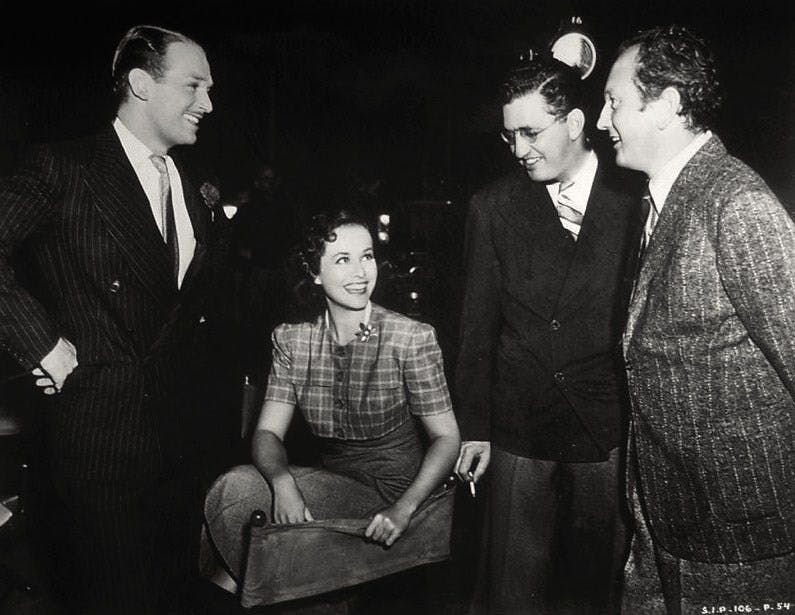Producing Hollywood in Its Heyday
In biographies, Selznick is often portrayed as officious, overbearing, and sometimes a hindrance to the actors and actresses he signed to contracts. Milan Hain is at pains to argue against the image of this producer as ogre.

‘Starmaker: David O. Selznick and the Production of Stars in the Hollywood Studio System’
By Milan Hain
University Press of Mississippi, 304 pages
David O. Selznick is best known for his production of “Gone With the Wind.” In the golden age of Hollywood, he was renowned for his choice of quality projects and his canny ability to promote them — as he did by screen-testing so many of Hollywood’s leading ladies and in his nationwide search for the right actress to play Scarlett O’Hara.
In the 1930s and ’40s, Selznick at MGM and then as an independent producer delivered film classics that were also box office hits — such as “David Copperfield,” “A Tale of Two Cities,” “The Prisoner of Zenda,” and “Rebecca.” He profited hugely from loan-outs of stars such as Ingrid Bergman in “Casablanca” (1942).
In biographies of Hollywood stars, Selznick is often portrayed as officious, overbearing, and sometimes a hindrance to the actors and actresses he signed to contracts. He appears as the very definition of a micromanager, rewriting scripts, hounding cinematographers about lighting and angles, and demanding that directors follow his hectoring instructions.
Milan Hain is at pains to argue against the image of this producer as ogre. Stars like Ingrid Bergman, Joan Fontaine, and Gregory Peck — no matter how talented — would not have had the same star impact without the Selznick treatment, which is dramatized in the producer’s version of “A Star is Born” (1937).
Bergman is the best example of the producer’s deft creation of a star. She had been a success in Sweden, and Selznick brought her over as a so-called natural star, one needing virtually no makeup, and a woman of impeccable character, married to a devoted husband and resolutely beyond any sort of corruption.
Yet Selznick realized that this natural quality had to be carefully maintained and highlighted by the use of subtle makeup that enhanced her near-perfect complexion, lighting that emphasized her best side, and camera angles that minimized her broad shoulders and height (she was 5 feet, 9 inches).
Just as important to the producer was controlling publicity, making sure Bergman’s German relatives and the Nazi regime were not mentioned. Selznick conceded that Bergman’s later adulterous affair with director Roberto Rossellini damaged her career because he had persuaded the public to believe in a figure of purity. That she could leave her husband and children for an Italian lover was an outrage to many moviegoers.
Selznick was most successful with young women who had not yet distinguished themselves. In the main, he relied on established male actors like Ronald Colman and Laurence Olivier, who remained available during World War II when leading men like Henry Fonda, Clark Gable, and Tyrone Power were in active service.
By the late 1940s, though, Selznick’s power as a producer waned. Mr. Hain suggests the producer became less disciplined about shaping the careers of actresses. In the case of Jennifer Jones, who became his wife, Selznick lost his sense of proportion and inflated her roles, to the detriment of the story values of a good script.
Selznick’s postwar failures, as Mr. Hain acknowledges, also had to do with the breakup of the Hollywood studio system and the increasing recalcitrance of actors who also became independent producers. By 1951, an exhausted Selznick no longer knew how to compete for the best actors and scripts.
The producer’s difficulties in the 1950s parallel those of Samuel Goldwyn, the ornery independent studio head who was never able to equal, let alone surpass, the great box office and critical success of “The Best Years of Our Lives” (1946). In the late 1940s and 1950s, Goldwyn and Selznick could no longer command the loyalties of stars in seven-year contracts that had been standard in pre-World War II Hollywood.
Mr. Hain might also have noted that postwar films now emphasized different kinds of actors, anti-heroes such as Marlon Brando and James Dean, whose acting styles and manners were out of sync with the historical epics and lush romantic dramas of 1930s and 1940s Hollywood that Selznick and Goldwyn favored.
“Starmaker” draws on Thomas Schatz’s 2015 study, “The Genius of the System: Hollywood Filmmaking in the Studio Era,” a seminal history that Mr. Hain uses to deepen our sense of how interrelated the means of production were with the advent of screen personalities.
Mr. Rollyson is the author of the forthcoming “Ronald Colman: Hollywood’s Gentleman Hero.”

